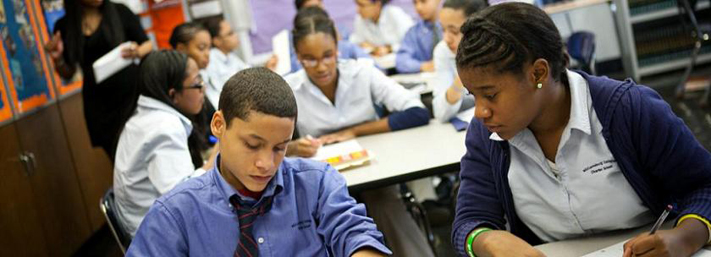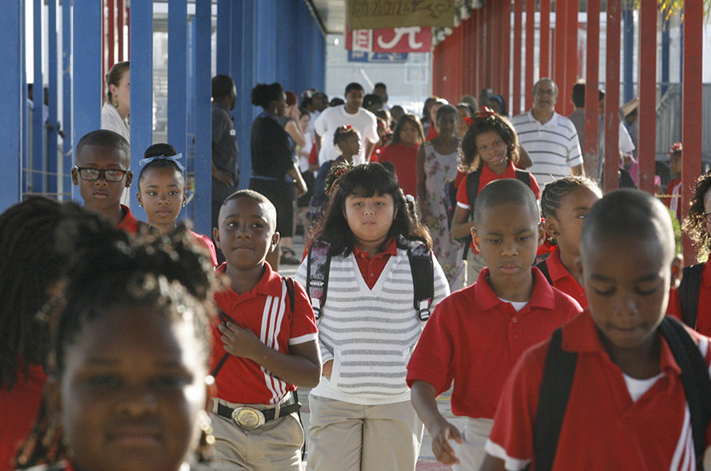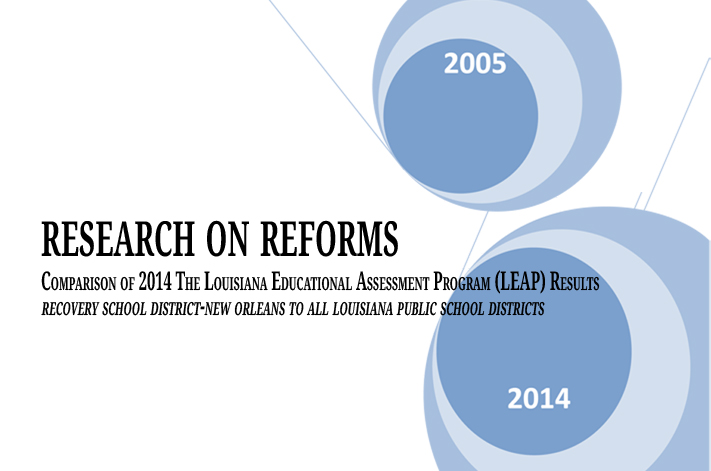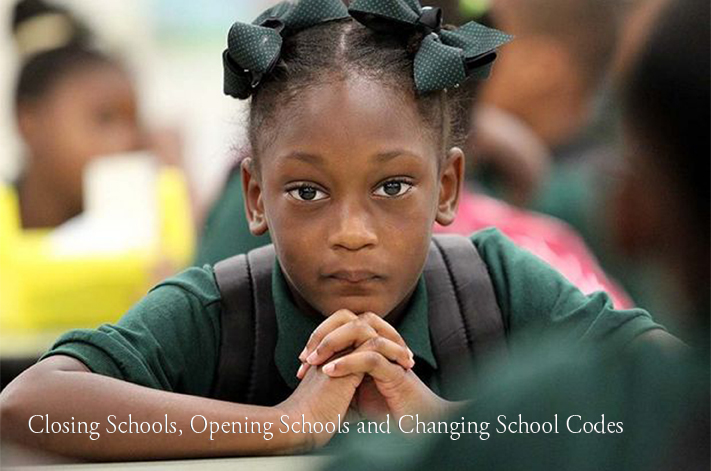Project Description
The League Of Women Voters Florida – Final Report
Statewide Study On School Choice And Consensus Report On Charter Schools
Introduction
The Florida League of Women Voters’ study on school choice was initiated to better understand the oversight of public moneys that are allocated to charter schools and other private educational institutions. How these public/private educational programs align with the constitutional requirement for a uniform, high quality school system of free public schools as stated in the Florida Constitution was also a concern. The League recognizes first and foremost it is a paramount duty of the state to provide for education. Charter schools, while privately owned and managed, are under contract to public school districts, funded by the public and accountable to the public.
This report includes the study methodology and the League’s principles and positions on school choice that were derived from the conclusions. This information will be used to revise the League’s Study and Action manual for issue advocacy. The appendices include consensus materials, highlights of individual studies, a study fact sheet, and a glossary.
Method
- Who do charter schools serve?
- Are charter school academic programs different from public schools?
- How are charters owned and managed?
- What types of school facilities do charter schools use?
Data for the study included 2011-12 individual school audits, school grades, school size, racial and socio-economic demographic information, and individual teacher/administrator salaries. Local leagues designed and conducted their studies. They gathered additional data from school visits, meetings with district officials and other studies. Study results were submitted to the state-wide chair person, and 18 consensus statements were written to reflect issues drawn from the studies. Each local league then conducted a consensus meeting to consider these statements. Consensus was reached on 17 of the 18 statements. It was not reached on the statement about the use of religious facilities to house charters. Following the adoption of the study by the League Board of Directors, education principles and League positions were written.
LEAGUE PRINCIPLES FOR SCHOOL CHOICE
- A uniform system should include the same requirements for educational content, certification, instructional hours and assessment for any school, public or private, that receives public money. Student admissions and dismissal policies should be uniformly applied to public and charter schools.
- Public moneys should not be allocated, directly or indirectly, to private schools or for
private school scholarships. - An efficient system must require that all students have access to appropriate educational opportunities within the public school system. Direct or indirect funding for public/private partnerships, if allowed, should complement district educational programs, not duplicate them.
- Local school districts must have management oversight responsibility of any school
within its district, public or private, that receives public money. Districts must report a school’s failure to comply with state regulations and/or contract agreements. They ensure that all criteria for staffing and administration, fiscal management including illegal assessment of fees, policy and procedural transparency, and procurement and facilities are met with no conflict of interest among the governing board or staff, the same as any public agency. The district should also have the primary authority not only to require corrective action but also to dissolve contracts when warranted. - A charter school must be organized by, and be operated by, a non-profit organization
by Florida law. The implementation of this law must be stringently applied. - Every student should have access to a free, high quality education regardless of race, family income or geographical location. Less expensive alternative schools that do not require the same standards for curriculum and instruction should not be allowed. Provision must be made for appropriate high quality services to meet the diverse needs of children. Accountability requirements should be the same for all schools funded with public money.
LEAGUE POSITIONS ON SCHOOLS CHOICE
The following positions are based on the League principles and the consensus statements.
Oversight
Charter School Purpose
Charter School Management
Both traditional and charter public schools require flexibility to develop schedules and curricula. The quality and stability of an experienced instructional staff is equally important. Teachers and administrators of ALL public schools, including charters, should meet certification and qualification levels commensurate with their duties and roles. Charter schools must have appropriately certified full or part time instructors on staff before applying for Exceptional Student Services funding. The community is best served if the compensation for public and charter instructional personnel is within a district’s maximum and minimum guidelines.
Transparency and Accountability
Conflict of Interest
Charter School Facilities and Funding
LWV Statewide Charter School Study Highlights
Individual study highlights were submitted by local leagues and compiled into the categories listed below.
Charter Teacher Turnover.
Maintain Local Control.
For Profit Management.
Innovation.
Serve Unmet Needs.
Resegregation.
Selective Admissions/Dismissals.
Poor Financial Management.
APPENDIX II
FACT SHEET: STATEWIDE STUDY ON SCHOOL CHOICE
I. Private School Florida Tax Credit (FTC) Scholarships
- In 2012-13, there were 51,075 FTC vouchers awarded state-wide at $4,335 each. Corporations received tax rebates by contributing to the Step Up for Children Foundation which distributes the scholarships to students who qualify for the Free and Reduced Lunch program. Total dollars disbursed was $206,974,102.
http://www.floridaschoolchoice.org/Information/CTC/files/Fast_Facts_FTC.pdf - McKay scholarships are funded directly from tax dollars to students with disabilities who have an IEP or a 504 plan. These scholarships may be awarded to public or private schools. Private schools received 26,611 McKay scholarships. IEP Scholarships averaged $7,019 each and 504 plan scholarships averaged $3977. Total money disbursed in 2012- 13 was $168,890,916. https://www.floridaschoolchoice.org/Information/McKay/files/Fast_Facts_McKay.pdf
- Private schools are not required to take the FCAT and do not receive school grades; their curriculum, accreditation, teacher certification, and evaluation standards are less stringent than the public school requirements.
https://www.floridaschoolchoice.org/Information/Private_Schools/choosing_a_private_school.asp - Most students receiving FTC and McKay scholarships attend private, religious schools: 73% of FTC students attended religious schools, and 64% of McKay students do. (same sources)
II. Charter Schools
Demographics
- There are 574 charters which is 14.5% of Florida public schools. Charters enroll 203,000 students.
http://www.floridaschoolchoice.org/Information/Charter_Schools/
http://dashboard.publiccharters.org/dashboard/schools/page/overview/state/FL/year/2013 - Charter school demographics: 37% Hispanic; 35% White; 23% African American; 5% Other. 51% Free and Reduced Lunch; 9% ESE.
- Public School demographics: 30% Hispanic; 41% White; 23% African American; 6% Other. 59% Free and Reduced Lunch; 19% ESE.
(Source: Fla.DOE.) - Charters have more racial imbalance than public schools: In 2011, 1/8 charters are 90% single race; 1/12 public schools are 90% single race; In Miami 25 charters hare 90% Hispanic above the 65% Hispanic percentage in Miami schools.
http://articles.sun-sentinel.com/2011-05-01/news/fl-charter-schools-segregation-20110501_1_charter-schools-florida-charters-marie-turchiaro
Management
- Charter schools are under contract to local school boards. They are funded at the same per student level as public schools plus (in 2013) the $91 million state PECO tax dollars to support maintenance and payments for privately owned buildings. Most districts, however, do not allocate local referendum funds to charters. Charters cannot do bond issues. http://www.fldoe.org/fefp/pdf/fefpdist.pdf. Public school districts with 2.5% growth received $6 million in PECO, others received none. http://www.fldoe.org/fefp/pdf/fefpdist.pdf
- Charter schools are managed by the charter holder or by either non-profit or for-profit educational management companies.
- Three for-profit management companies control 27% of Florida’s charter schools. Management fees of about $450s per student are usual. In addition to lease or debt service payments that are often at least 20% of the total school budget:
- The three largest for profit management companies in Florida are: Academica: 91schools, Charter USA: 44, Imagine: 14. They account for 27% of charters. (Source: websites). Source: Auditor General http://www.myflorida.com/audgen/pages/chschools_efile%20a-h.htm.
- If a charter closes, the facility remains with the private owner. (Fla.DOE)
·Florida Auditor General Summary Findings of Charter Schools: 1) 15 audits were not submitted in 2011-12; 27 audits were more than 45 days late, and 4 were received after the March 2013 deadline. 2) Audits disclosed instances of noncompliance with certain requirements, primarily related to the reports, letters, and financial statement note disclosures. 3) Comprehensive review of a sample… disclosed apparent noncompliance primarily related to the presentation of financial statements and note disclosures, budgetary comparison schedules and schedule of expenditures required for Federal Single Audits.
Achievement
- Charter schools participate in the FCAT and school grade programs. There is no consistent difference in achievement for charters and public school students. (Source: CREDO: http://credo.stanford.edu/research-reports.html)
- One percent of public schools had an F school grade on FCAT , and 6% of charters did in the 2011 school grades report
Charter Closures
- Nationally charters close for the following reasons: financial 41.7 %; mismanagement
24% and academic 18% (Center for Educational Reform 2011) - Statewide closure rate of charters is 20% percent. Charters are 50% of all F rated schools in 201 (source: http://jacksonville.com/opinion/blog/479262/jeff-reece/2011-07-28/edujax-half-floridas-failing-schools-are-charters

Conflict of Interest Concerns
- Senator John Legg Chair of Senate Education Committee is co-founder and business administrator of Daysprings Academy in Port Richey.
- Senator Kelli Stargel from Orange County is on board of McKeel Academies. She is on the Education Committee and sponsored the Parent Trigger Bill.
- House Budget Chairman Seth McKeel is on the board of McKeel Academy Schools in Polk County.
- Anne Corcoran, wife of future House Speaker Richard Corcoran has a charter school in Pasco County. http://www.tampabay.com/news/education/k12/pascos-classical-prep-charter-school-delays-opening-for-a-year/1276912. Richard Corcoran is Chair of the House Appropriations Committee.
- Senator Anitere Flores of Miami is president of an Academica managed charter school in Doral.
- Florida Representative Erik Fresen is Chair of the House Education subcommittee on appropriations. Representative Fresen’s sister is the Vice President of Academica and is married to the president. http://www.tampabay.com/blogs/the-buzz-florida-politics/content/ethics-commission-clears-miami-rep-erik-fresen-alleged-voting-conflict
http://www.tampabay.com/blogs/the-buzz-florida-politics/content/ethics-commission-clears-miami-rep-erik-fresen-alleged-voting-conflict - George Levesque, Florida House lawyer cleared Erik Fresen of conflict of interest concerns over charter schools. He is the husband of Patricia Levesque, former Jeb Bush Deputy Chief of Staff and currently Executive Director of the Foundation for Excellence in Education which promotes school choice.
http://www.truthabouteducation.org/1/archives/01-2010/1.html. - Representative Manny Diaz is Dean of Doral Academy, an Academica managed school. He is the leader for the new statewide contract bill in the Florida House. Doral College was cited by the Florida Auditor General for a $400,000 loan from Doral Charter High School. Conflict of Interest and procurement for Charters with federal grants: http://floridacharterschools.org/schools/taps/conflictinterest_att.pdf
APPENDIX III – GLOSSARY
Conversion Charter Schools are traditional public schools that have been converted to charter schools. The school must have operated for at least two years as a traditional public school (including a school-within-a-school) in a school district before conversion. Application for a conversion may be made by a parent, teacher, principal, district school board or school advisory council, but must be approved by a majority of the teachers and a majority of the parents. A majority of the parents must participate in the vote.
Virtual School. provides educational opportunities to take courses full time or par time in grades K-12 online. In Florida all teachers must hold Florida Teaching certificates and the curriculum must meet state standards. If students participate in a virtual school full time through their local public school they participate in state assessments and receive school grades.
Florida Education Finance Program (FEFP) is the program set up in 1973 which uses a formula to allocate funding to local school districts. http://www.fldoe.org/fefp/offrfefp.asp
Full Time Equivalent (FTE) A student who takes a full time course assignment is a one FTE student. If they enroll part time they receive a proportional FTE. An example is a half time student. This student would be 0.5 FTE.
Weighted FTE is used in the funding formula for calculating a district’s funding allocation. It is calculated by multiplying the total District student FTE by a program cost factor.
Program Cost Factor assures that each program receives an equitable share of funds in relation to its relative cost per student. Some of these costs include: declining enrollment, virtual education, transportation, reading programs, exceptional education and English as a second language.
Florida Tax Credit (FTC) Scholarships are funded by private corporations that deposit tax money
owed to the state directly to a nonprofit (Step Up For Children) that then distributes it to needy applicants to attend a private school.
504 Plans are developed by school teams and parents to support the educational needs of a K– 12 student with a disability that “substantially limits one or more major life activity” such as learning, speaking, listening, reading, writing, concentrating, caring for oneself, etc.
Individual Education Plan (IEP) -Each public school child who receives special education and related services must have an Individualized Education Program (IEP). Each IEP must be designed for one student and must be a truly individualized document.
McKay Scholarship Program is designed to offer parents of disabled children the opportunity to have their child attend a private school that meets their educational needs. Students with a learning disability must have a 504 plan. Children with physical disabilities must have an Individual Education Plan (IEP). Both groups must be enrolled the previous year in the public school. Students from military families may also be eligible but may be exempt from the local school enrollment requirement. http://www.floridaschoolchoice.org/information/mckay/
Title 1 is a federally funded program designed to help schools that serve low income families with reading and math skills. Schools must have more than 56% of the students eligible for free or reduced price meals. Funds are allocated on a per qualifying child basis. Federal law requires that a district not use Title 1 funds to offset expenses to a Title 1 school that would normally be paid by other sources if Title 1 funds were not available.
Exceptional Student Education (ESE) Is designed for children who have special learning needs. They are called exceptional students. Exceptional students include children who are gifted and children who have disabilities. Children who are considered gifted are those children with superior intellectual development and who are capable of high performance. The purpose of exceptional student education is to help each child with an exceptionality to progress in public school and prepare for life after school. ESE services include specially designed instruction to meet the unique needs of the exceptional student. There is no charge for these special services.
Education Management Organizations (EMOs) are for-profit or non-profit organizations that manage public schools. In contrast to traditional vendors that are contracted to provide specific services (e.g., professional development, payroll, food services) to districts and schools, EMOs are contracted by districts to manage and run individual schools, both traditional as well as charter schools, or clusters of schools. EMOs that manage networks of charter schools are referred to as charter management organizations (CMOs). The parameters of an EMO’s management responsibility are spelled out in a performance contract between the district and an EMO.
Florida State Facilities Requirements are a comprehensive set of guidelines related to the safety of state owned educational facilities. It includes such items as hurricane safety, asbestos removal etc. Charter schools, except conversion charters, are exempt from these requirements but must meet Florida building and minimum fire safety codes.
APPENDIX IV Consensus Packet
Some Thoughts on Educational Reform
Information is coming at us from every direction and in many forms. Traditional ways of organizing information are splintering e.g. newspapers, television, and books are becoming blogs, chats, YouTube, and urls from everywhere. The information industry is changing rapidly. Companies are trying to bundle hand held devices, computers, telephones, and televisions to control markets while consumers are asking for choice in programming and how it is delivered. The tension is real and extends into the educational sector of our economy.
Traditional education is also becoming unraveled. Textbooks are online and some are even replaced by more narrowly focused articles and or repositories of exercises to facilitate learning. There is an information overload, and traditional classrooms are not equipped to help children sort through and evaluate what they must know. Ordinary jobs for ordinary people are disappearing. We read that the new jobs require critical thinking, but what new jobs are these, and how do we train students for them?
Higher education is responding by encapsulating the best lectures, through MOOCS or ‘star faculty’ online courses. In addition, students have a plethora of research studies and articles to absorb. But, the real learning occurs when students interact with the content and each other in a setting where they are forced to confront their own and others’ views in ways that expand their perspectives. They need meaningful interaction with excellent facilitators. Who are these facilitators? How are they credentialed? What career paths do they have that will attract highly qualified people? Currently, most faculty lecture 6-9 hours a week and are expected to do research and other service the remaining time. This will change; the lectures will be online. Meaningful discussion doesn’t happen in a room holding 500 students, and small groups are expensive. Who will the ‘new’ faculty be?
K-12 education faces these same questions. Information will not just come from teachers and textbooks. Students will get more information online, but how? Where will the costly technology come from? Who monitors the process? Who facilitates the integration of knowledge? How accountable is online learning?
Are current practices flexible enough to break apart individual classrooms to provide more economical large scale information dissemination in media centers, computer labs, or at home? Are teachers trained to integrate this information from different sources and areas of knowledge, and help students learn how to make sense of it all?
We are living through a time of change where old institutions may be inadequate and new ones have not been well conceptualized. We are experimenting with our children’s futures. Yes, schools must change in form and function. These changes will not save money, but they may very well rearrange how it is spent. As we break apart our old institutions, we have to manage this change so that resources are not dissipated through opportunistic schemes, and talent is not lost from declining opportunities.














